The beef and pork stood out at the meat counter of the supermarket, which always looks splendidly full on a Saturday morning, and especially inviting on a cold winter's day, when most people are trying to decide what they'll be cooking at home during the weekend.
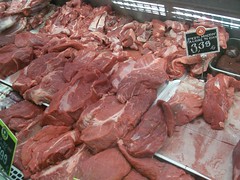
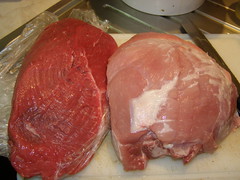
French beef is sold in large multinational supermarket chains (INKA, the locally owned supermarket, sells only Greek beef); I bought a kilo each of beef (left) and pork (right).
But take note: the beef displayed here is not local food; this beef is imported from France. We prefer French beef to the locally reared beef, mainly because the locally reared beef is very stringy and fibrous; it takes ages to cook, and never seems to have that melting quality about it that French beef has. France has a longer history in raising beef; Crete has a tradition in pork and lamb/goat, but not beef.
Whole onions, preferably small ones (scallions), are a traditional feature of Greek stifado.
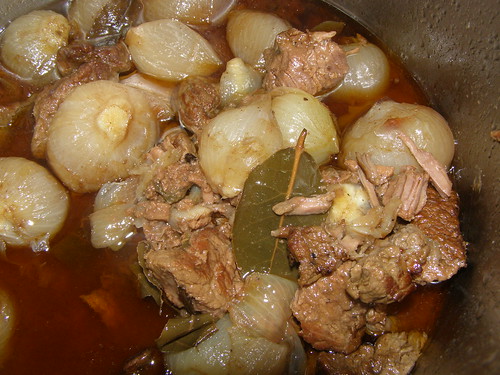
For the beef, I decided on Souvlaki for the Soul's stifado, a stew cooked in the traditional Greek style, with dry spices and lots of onions. Stifado is often served with fried potatoes in Greece, but it also goes well served on a bed of rice or mashed potatoes. We had this with some green salad, sourdough bread to mop up the sauces, and some imported English ale, which is now becoming easier to buy - competitive supermarket price and product wars are all part and parcel of the more globalised place that Crete has now become.
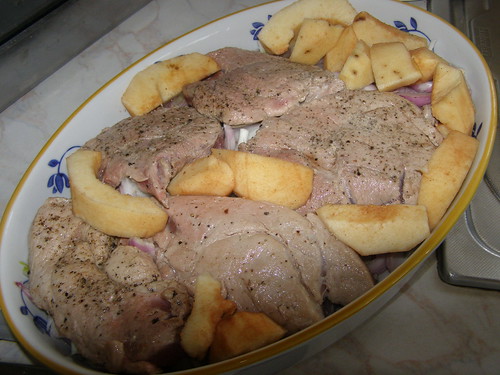
This is what the pork dish looked like when it went into the oven - we forgot to photograph it once it was cooked!
For the pork, I sliced up a ton of onions, placed them in a baking tin and laid the pork in thick slices on top of the onions, filling in the gaps with quince slices, which gave the whole dish an enticing aroma. There was no real recipe to this; its simplicity won over in terms of taste. Quince cooked with pork is a popular combination in Greek cuisine.
This kind of cooking style is typical of my Sunday meat dishes. They are usually simple, but they are always cooked with olive oil, using high-quality fresh ingredients.
Notice how animal's tail is still attached at the local store. That's how people buy their meat in such a store: this way, they know it's a goat and not a lamb. Likewise, they ask about which village or farm the animal was raised, what it was fed on, and if the animal was a male or female(!). This kind of information is clearly not available in the multinational store, where all meat is displayed in an almost packaged form. To be global, or not to be global, that is the question these days...
©All Rights Reserved/Organically cooked. No part of this blog may be reproduced and/or copied by any means without prior consent from Maria Verivaki.

This is what the pork dish looked like when it went into the oven - we forgot to photograph it once it was cooked!
For the pork, I sliced up a ton of onions, placed them in a baking tin and laid the pork in thick slices on top of the onions, filling in the gaps with quince slices, which gave the whole dish an enticing aroma. There was no real recipe to this; its simplicity won over in terms of taste. Quince cooked with pork is a popular combination in Greek cuisine.
This kind of cooking style is typical of my Sunday meat dishes. They are usually simple, but they are always cooked with olive oil, using high-quality fresh ingredients.
*** *** ***
When shopping, I usually go to a range of stores. It isn't uncommon for me to go to two different supermarkets on the same day if I'm searching for food items that I know are only available in the one or the other. For example, we like the bread found at the local supermarket, but prefer the beef at a branch of a multinationally-owned supermarket. Here's what the meat counters looked like at two different supermarkets on the day I bought these cuts of meat.Notice how animal's tail is still attached at the local store. That's how people buy their meat in such a store: this way, they know it's a goat and not a lamb. Likewise, they ask about which village or farm the animal was raised, what it was fed on, and if the animal was a male or female(!). This kind of information is clearly not available in the multinational store, where all meat is displayed in an almost packaged form. To be global, or not to be global, that is the question these days...
©All Rights Reserved/Organically cooked. No part of this blog may be reproduced and/or copied by any means without prior consent from Maria Verivaki.
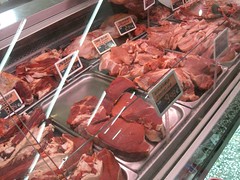
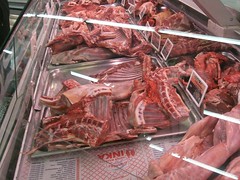
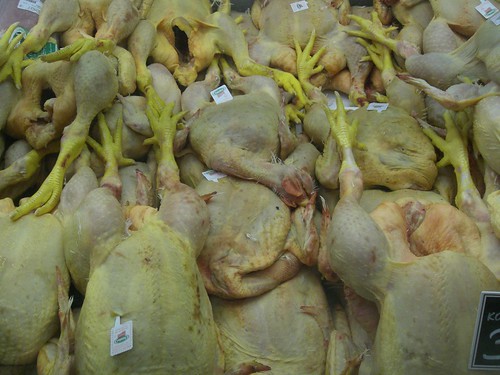
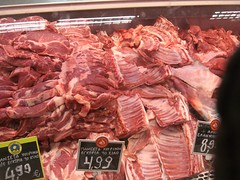
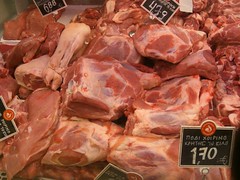
Is there an increase of French beef consumption in Chania? In Athens, it seems that there is a permanent decline in French beef eating, because of the fear of mad cow disease. People prefer either Greek beef or imports from non French producers within the EU.
ReplyDeletePut it this way - in Hania, in the biggest branch of Carrefour, the counter is FULL of beef: all French. There is more beef than pork, goat, lamb (Italian chicken is also sold in large quantities). At Carrefour, people line up on a Saturday morning for at least a quarter of an hour to wait their turn to buy meat.
ReplyDeleteThe INKA counter never sells so much beef, which is of course all local. Possibly, the people who buy their meat at INKA are locally-oriented, and probably buy most of their meat from a village butcher who sells only Greek meat. The beef sold at INKA is never really given the chance to tenderise - it is on sale in less than a week from the moment the animal was slaughtered.
The meat at Carrefour always looks appetising. People who buy their meat there are usually 30-60 years old, and look like town dwellers (from their clothing). Possibly, price is more important to them (Carrefour has good specials on both beef and pork), while localness of product is more important to INKA meat buyers (who usually have the look of the villager).
Interesting to see chickens with the feet attached as the feet are always removed before display here. In NZ the quality of meat varies between supermarkets - even those in the same chain. Luckily my regular place has good quality.
ReplyDeleteMaria - those are two beautiful pieces of meat you bought and what great ways to cook them. I'll remember pork with quinces for the quince season that starts in about April here
good point mickle about chicken legs - people freak out when they see them being sold, but people rarely use them to make anything more than soup. you are always asked if you want them included, so you don't actually have to pay for them if you don't want them, but i always buy them. we use them to make stock and then we give the cooked legs to the dog
ReplyDeleteSe efharisto gia ti diefkrinisi!
ReplyDeleteIt is interesting to compare origin labelling in Europe to Australia, because the distances in Europe are smaller. A label like "Product of Australia" is not really very useful when considering food miles, but we very rarely see more specific provenance. Tasmanian produce is sometimes labelled, which I think is to advertise the clean image, but I've never seen something labelled NSW.
ReplyDeleteThanks for the shout out Maria! Interesting to note about the labelling and how popular beef is! I also adore your pork and quince dish!
ReplyDeleteOK, I'm back! I can't catch up, but I'm trying to go through my comments (in reverse chronological order, so you're near the top at the moment)to visit! I hope to be a more regular visitor... hope.
ReplyDeleteYou always have such interesting things to say about food. All the local supermarket info like tails and knowing the sex amazes me.
My comment on French beef is that as I know from my UK days young animals are by law not slaughtered and consumed in the UK so they are transported alive to France, raising concerns for their well being from PETA and other activists. So there is a fair chance that French beef from young animals that we so much like in Greece is actually British. I lived in the UK through the second mad cow scare and people wouldn't buy beef for a couple of days and then the supermarkets dropped the price by half and it disappeared from the shelves.
ReplyDelete